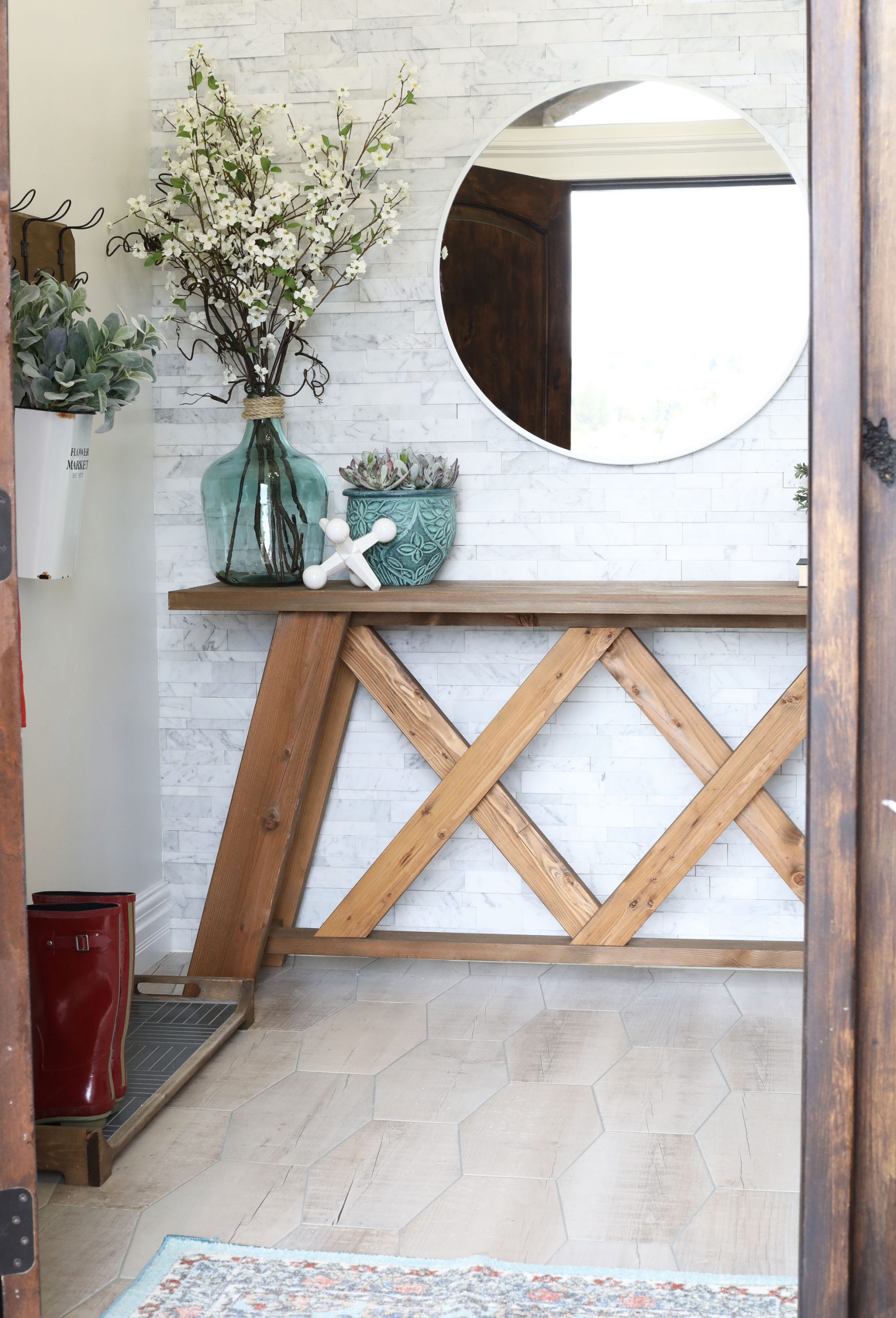How To Tile Your Floor To Create a Lasting Impression
Posted August 9, 2019Guest post by Amy Baesler of Her Tool Belt
At first sight, tiling might seem like a big undertaking. And right now, you’re probably thinking, “I have no idea how to tile my bathroom floor. The project is too big and I don’t know where to start.” Well today, we’re dispelling some of the most common misconceptions about tiling.
Amy Baesler of Her Tool Belt recently renovated her entryway in Season 3 of the Renovation Challenge and shared a great how-to guide for tiling a new space. From prep to finishing touches, Amy takes us along for an easy to follow tiling project that will create a first impression that lasts a lifetime.
Here’s what Amy’s space looked like before…

And what it looks like now!

Amy removed her old tile using a rotary hammer removing not just the tile but also the old thinset underneath that held the tiles in place. This helps provide a clean slate for your beautiful new tile.
Now, let’s dive in to learn more about tiling a space from Amy.
Prepping the Floor
To get rid of the old tile I used a rotary hammer and it did a pretty great job cleaning up the subfloor during floor demo, but then I had about a million staples to pull up from the metal mesh. I vacuumed up all the dust and started with the mortar bed.
ProTip: A good system for DIY’ers to get a good solid base for tile is with mortar (thinset) and cement board. My room was small enough that if I bought the larger 4′ x 8′ cement board sheets, then I’d only have 1 seam to tape. (For more on cement boards and how to install check out this blog post.)

I mixed up a batch of mortar and used the ¼” x ¼” square notch trowel to spread the mortar.
Then I laid the cement board on top. Using a laser line, I secured the cement board down on my floor joists. Really you should put the rock-on screws every 12″. The easiest way to install the rock-on screws through the cement board is with an impact driver. The impact driver really takes out the effort of drilling through cement board.

Once all the cement board was secured to the subfloor, I taped the seam with seam tape and mortar/thinset.

And my little helper ‘signed’ the floor with her footprint.
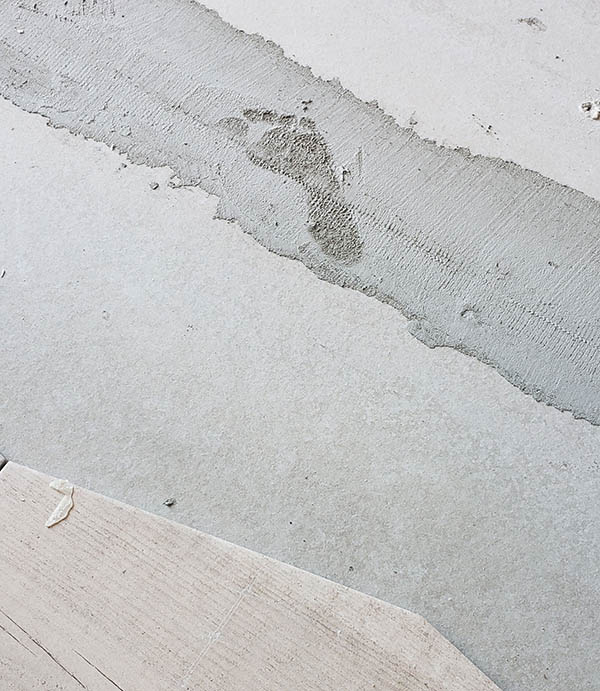
I let the cement board layer cure for 24 hours minimum.
Setting the Floor Tile
For the floor tile I picked this fun Oakwood Lily Hexagon tile, it’s a fun twist on the standard wood looking tile.
I first laid out a few rows of the tile to see how the spacing would work out. Luckily about a 1/2 tile on one side of the room ends with about a 1/2 on the other. At the door, I started with a whole tile and a half tile and that worked out great. I was able to make some preliminary cuts to make the tile-laying process go smoother.
For this size of tile, I used a ¼” x ⅜” square notch trowel. I evenly applied thinset to the cement board and pulled back on the trowel at a 45-degree angle for the final pass.

The tile was placed on the thinset and slightly jiggled. I used 1/16″ spacers. The tile box suggested 1/8″, but I really wanted small grout lines and 1/16th worked out perfect. A straight board or level is helpful to make sure you’re level between tiles.

A little close up of the action.

Once the tiles were all set, I allowed the thinset to cure for 48 hours without any little helpers walking on it…that may have proved difficult!
Grouting the Oakwood Lily Hex
I took a piece of the oakwood lily tile to the Home Depot to pick out the grout. There were a couple of grouts that looked really nice, but I settled on natural gray. I decided to use a premixed grout since my area is pretty small. The Fusion Pro grout promised no sealing and no staining, so I tried that option.
ProTip: There are hundreds of grout options so don’t limit yourself. Watch this Coffee Chat all about grout.
Grouting is a simple job but it does take some time.
I take my float and just put grout on the front tip and pack it into the grout lines.

Then use the float to scrape off the excess grout going in the direction of the grout lines. This seemed to give me the smoothest result.

The Fusion Pro grout was a little different than the regular stuff, you only wait 1-4 minutes before you wipe off the tile with a wet sponge.

Then take a wet microfiber cloth to wipe off any residue of grout from the tiles…and move on.
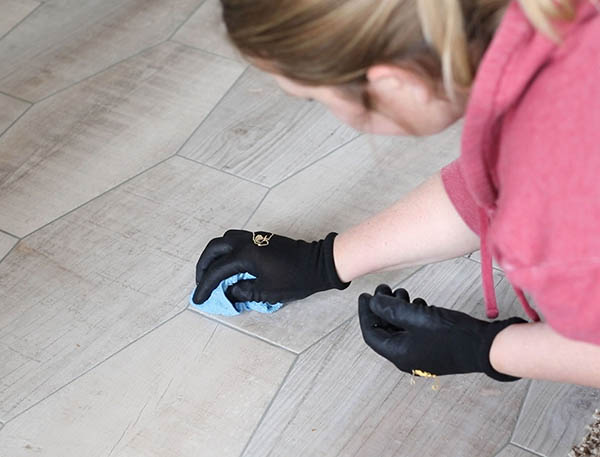
The grout needs to dry for 24 hours. It looks pretty darn nice. I couldn’t be happier with the way it turned out.
After Amy completed her floor tile, it was time to move on to her feature wall tiling all the way up to the ceiling. We love a good feature wall and how simple Amy made the process. Taking a look at her tile selection and application helps make tiling much easier than you might have thought.
Tile Wall Prep
The new wall in the entry will be covered with tile, so instead of sheetrock, I chose to put up 1/4″ cement board. I used the 4′ x 8′ sheets, so it doesn’t have the typical lines that cement board has. I used Rock-on screws and my impact driver to attach it to the wall studs. Cutting the angle was fun, along with hanging cement board 12′ up. 🙂 My husband had to give me a hand there, I like to pretend I’m tough, but I’m not that tough.
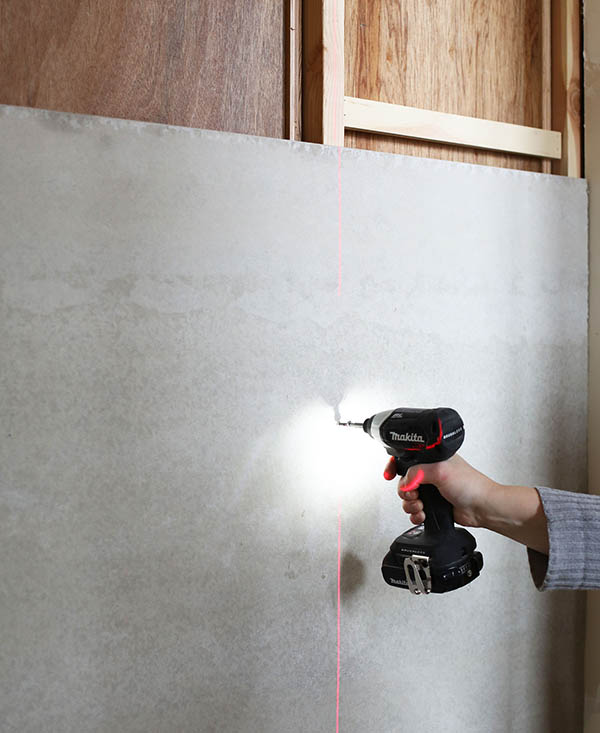
As you can see between the studs, I slid my cabinet carcasses in before attaching the cement board. I wanted to make sure they fit before covering up the wall.
Setting the Marble Ledger Tile
The Carrara Ledger mosaic tile couldn’t have been easier to install. It only took me about 6 hours to do this whole wall, and half the time was probably unwrapping the tile. They are lovingly packaged.
I wanted to make sure I started off perfectly level, so I cut a 6″ piece of wood and leveled it and screwed it to the wall.

Then I used the V-notch trowel to spread tile adhesive (mastic).
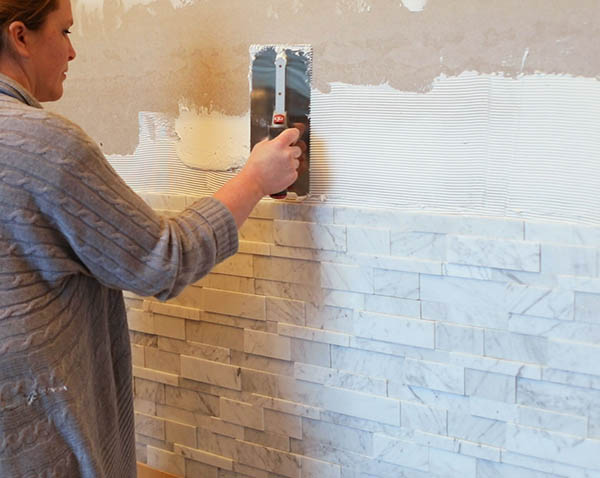
And pressed the mosaic ledger tile into the adhesive.
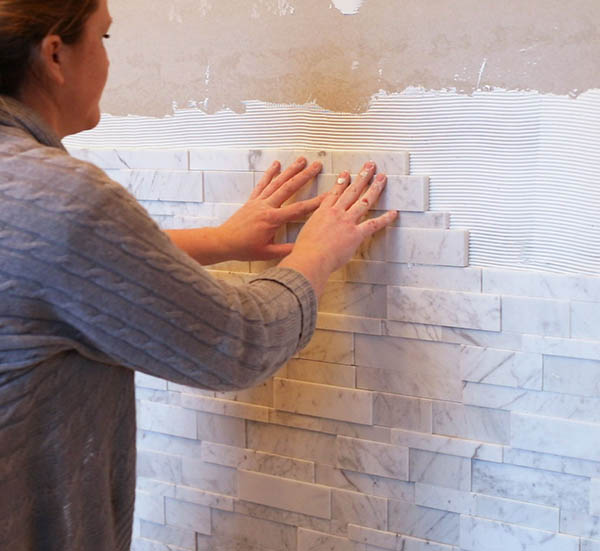
I was ridiculously lucky and I would have to cut a mosaic to start the row. However, that cut off fits perfectly at the end of the row. How did I get so lucky? Also, I find that when cutting natural stone mosaics, I get a cleaner cut if I cut the mosaic upside down. (This might only be the case with my type of tile saw.)
This particular mosaic tile I choose didn’t need to be grouted as its intended purpose is to have clean lines. It was perfect to start to enjoy the space a little sooner.
Now, I feel like I can be proud of the space I created and love inviting friends over, with my new and inviting entry that is a definite wow factor.

Subscribe to our YouTube channel for more helpful videos on design, renovations and all things tile!

